With a Red-tailed Hawk thrown in for good measure.
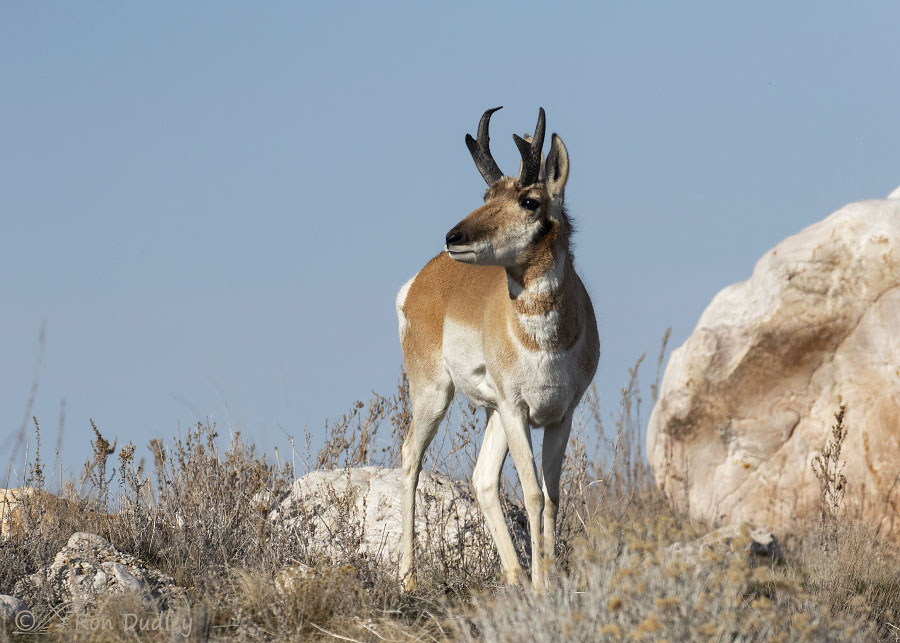
1/5000, f/6.3, ISO 500, EF 100-400mm f/4.5-5.6L IS II USM @ 271mm, not baited, set up or called in
After not seeing Pronghorn on Antelope Island up close for a very long time I’ve finally been seeing them a little more often lately. Six days ago I found three handsome bucks hanging out right next to the road so I took a few shots. They were so close to me and to each other I could never get enough depth of field to get more than one of them sharp so I concentrated on this guy who was a little bit separated from the other two.
I like this shot for his noble pose and the Tintic Quartzite boulder to his left. Light colored Tintic Quartzite outcrops and boulders are relatively young rocks that are highly resistant to erosion so they’re easily seen on the northern third of the island (Ladyfinger Point especially).
Birds such as Chukars, Willets and various songbirds like to perch on them so they’re found in many of my photos but I seldom get a chance to include most or all of a single boulder in the frame. I have a love/hate relationship with those boulders because they’re an iconic symbol of the island but because of their very light color they can be an exposure nightmare for the photographer when a darker bird perches on them.
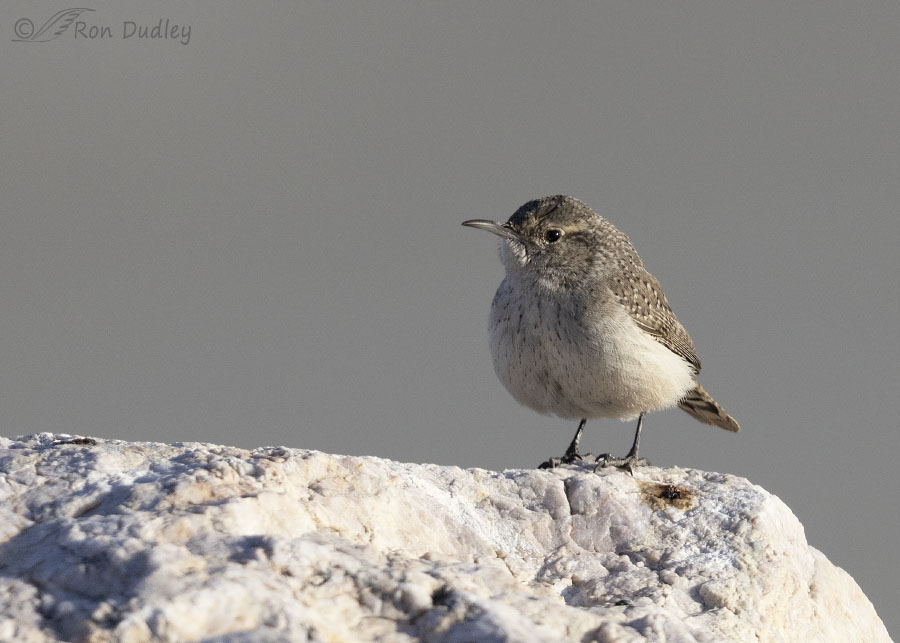
1/5000, f/5.6, ISO 500, Canon R5, Canon EF500mm f/4L IS II USM + 1.4 tc, not baited, set up or called in
Two days after I photographed the Pronghorn I found this Rock Wren singing away atop another one of the Tintic Quartzite boulders a little further to the east. He was far away and I didn’t like any of my singing shots but it’s unusual for me to get a Rock Wren in my viewfinder so I decided to include a couple of documentary photos in today’s post.
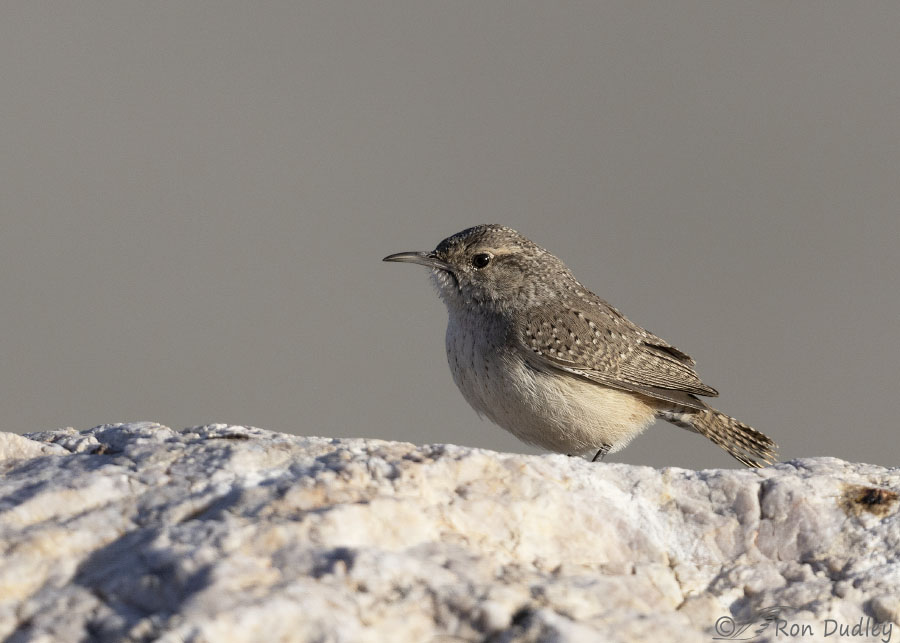
1/5000, f/5.6, ISO 500, Canon R5, Canon EF500mm f/4L IS II USM + 1.4 tc, not baited, set up or called in
The only time I got a broadside look at him his legs and feet were hidden .These photos were taken early in the morning before the light got harsh so acceptable exposure wasn’t as much of a problem as it usually is.
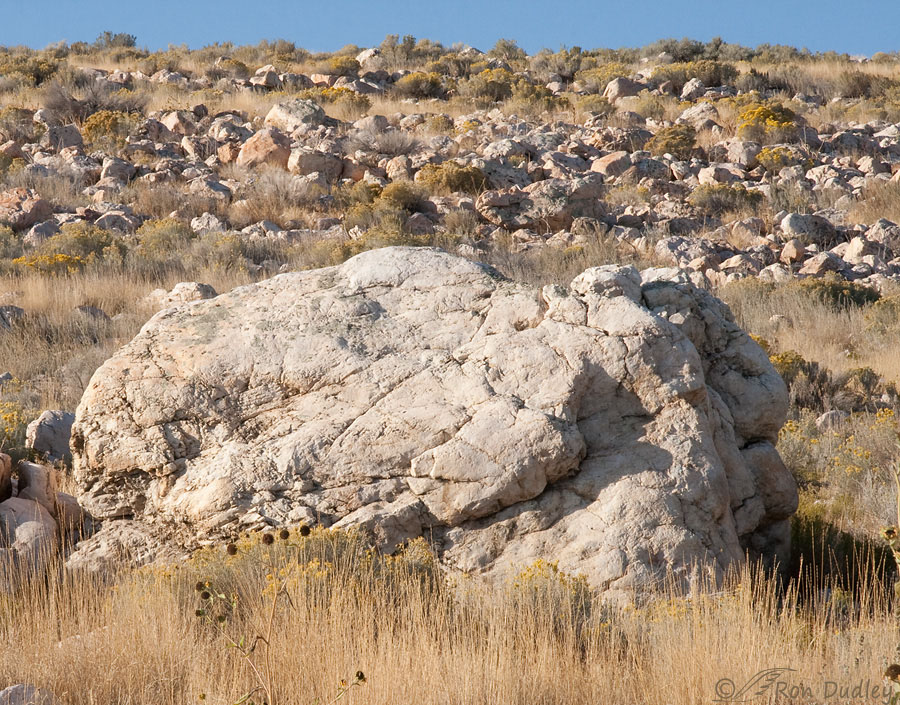
This area next to the road on the north end of the island provides the best look at the Tintic Quartzite outcrops that most visitors to the island get. Tintic Quartzite was formed in the Cambrian Period about 540 to 570 million years ago but geologically speaking that’s young so they’re some of the youngest rocks in Utah.

Antelope Island is a place of contrasts. Much of the southern 2/3 of the island has exposures of much darker Farmington Canyon Complex rocks formed about 2.5 billion years ago so they’re the oldest rocks on the island and some of the oldest in Utah. For a perspective on relative time, the oldest rocks at the bottom of the Grand Canyon are only about 1.8 billion years old.
Farmington Canyon Complex rocks are so dark they often look nearly black but this photo was taken early in the morning in very warm light so their color isn’t accurate.
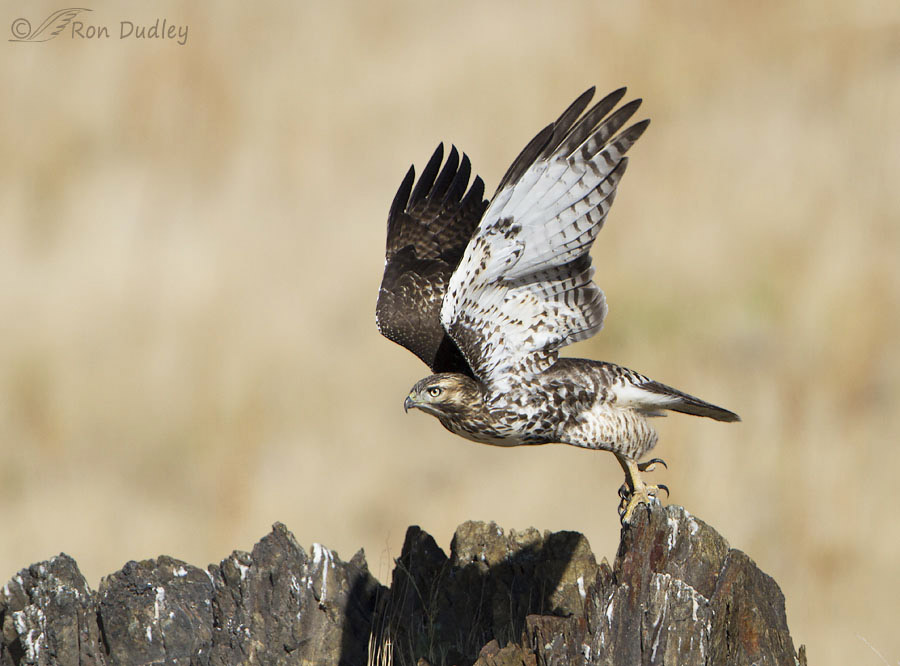
1/2500, f/6.3, ISO 400, Canon 7D, Canon EF 500mm f/4L IS USM + EF 1.4 III Extender, not baited, set up or called in
This immature Red-tailed Hawk was taking off from some of the same Farmington Canyon Complex rocks seen in the previous photo. Their color in this photo is much more accurate.
So next time you visit the island, if you ever do, I hope today’s post will enhance your appreciation of it. The island has a lot to offer that many visitors are unaware of.
Ron


What a wonderful group of shots today! They’re coming in crisp and clear even on my phone. Thank you for a bit of geology tutelage today. I’m a fan of abiotic factors too!
Once again, your daily post was very timely for me. I took a photograph yesterday of what looked to me like a red-tailed hawk except that there was a lot more stippling and the tail wasn’t red. It looked exactly like the hawk in your photo above. Thanks so much for the inadvertent ID help — this isn’t the first time that has happened. Question: are there rules about using adjectives such as fledgling, immature, juvenile or young when describing the age of birds? I’ve been having fun figuring out the age of the various bald eagles we have in our area that I manage to capture with my lens, but don’t know the correct terminology to use when describing them.
Question: are there rules about using adjectives such as fledgling, immature, juvenile or young when describing the age of birds? I’ve been having fun figuring out the age of the various bald eagles we have in our area that I manage to capture with my lens, but don’t know the correct terminology to use when describing them.
Karen, red-tails don’t develop their red tail until they’re adults. And adults have dark eyes. Immature red-tails have light eyes like this one.
Here’s what I do. I only call them fledglings when I know they’ve recently left the nest. I’ve kinda stopped using “juvenile” in most cases and use “immature” instead. I use “young” as a catch all meaning they haven’t reached adult plumage and/or sexual maturity.
Thanks so much!
Thank you.
How I wish that I could visit. It is highly improbable now so I am very, very grateful for the education (and temptation) you provide…
Thanks, EC. I wish you could too.
Neat photos, I seldom see rock wrens on the Island. I love the partial side light on the wren. Yes, to many the island is bland but from September to biting gnat season I love being out there.
I was on the island again this morning, April. The light up there was much better than it was down here. Things are finally picking up on the island.
How special it is to see a Red-Tailed Hawk today in honor of Chris.
Randy, even though they’re common, red-tails are always special to me.
Thanks for the geology lesson of Antelope Island. Do Rock Wrens like rocks more than other small birds?
“Do Rock Wrens like rocks more than other small birds?”
Far more than most, John. Here’s part of what Cornell has to say about their preferred habitat – “the Rock Wren is strongly associated with exposed rock habitats: canyons, cliffs, boulder fields, rocky hillsides, and dry rocky washes.”
A nice mammogeoornithological tour. Add a plant in there and it’d be a real mouthful. I’m taken with the “Rock Wren on Boulder”, but all are engaging, the more so because of your commentary.
Lyle, I considered running with that “Rock Wren on boulder” bit but I couldn’t come up with anything worthy of the effort. A creative lapse on my part…
Thanks for the geology lesson !! I will look a little closer at the rocks next time I get to visit AI !!
“I will look a little closer at the rocks next time I get to visit AI.”
Good! Part of my goal with this post was to spark that interest in my readers.
Fascinating post! Thanks for the education.
Thank you, Linda.
I really liked this morning’s inclusion of geological context and attendant
information…..I like that you’re interested in such a wide variety of things
and think to pass them on, as well as the beauty that you capture.
Kris, I’ve been quite interested in geology ever since I took a geology course in college way back in the late 60’s. Moving to Utah, a geological wonderland, only sparked my interest.
Your final remark is so true of all of nature. Thank you for your contributions to my knowledge and appreciation.
You’re very welcome, Burrdoo.
Wow – very interesting post this morning. Pronghorn, Wrens, quartzite rock, 2.5 billion year old rock, and a Red-tail. And a lesson in geology. That Pronghorn shot is beautiful. We have lots of quartzite here too. Thanks for posting Ron.
Thank you, Everett.
Nice! One doesn’t mind when something like the antelope makes a liar out of you. Guessing those Rock Wrens are as “twitchy” and house wrens – good capture!
Guessing those Rock Wrens are as “twitchy” and house wrens – good capture!  Geology and how it can radically change over relatively short distances is always interesting not to mention how it shapes everything. Red-tailed hawk always welcome.
Geology and how it can radically change over relatively short distances is always interesting not to mention how it shapes everything. Red-tailed hawk always welcome.
3 or 4″ of WED snow last night – MUCH needed and worth busting my ass clearing out the garden and picking up sticks from the wind over the winter the past few days as “spring” will happen now and get ahead of me as it always does……
“One doesn’t mind when something like the antelope makes a liar out of you.”
I agree, Judy. April Olson says she sees more Pronghorn while riding her bike on the more inaccessible south end of the island so I’m hoping most of them are hanging out down there.
This morning I saw the same 3 buck Pronghorn hanging out together in almost the same place I saw them on the day I took the photo above.
Congrats on your snow! We had about two spits of rain about a half hour ago.
I was delighted by your picture of the rock wren. And reading your blog reminds me of my brief time living in Murrayville in corporate housing. Gorgeous place.
Murrayville? Where’s that, Arwen? I’m not familiar with it.
Following your site I feel like I get to have a virtual vacation to Utah each morning. I have a former colleague who lives in the SLC area. One day I hope to visit and when I do I certainly will visit Antelope Island.
All the shots are great (as usual), but being a hawk guy that young Red Tail action shot is my favorite.
“Following your site I feel like I get to have a virtual vacation to Utah each morning”
Excellent, Michael. I’m very glad to know that.
A wonderful series of photos and educational material. Thanks Ron. And a special thank you for including the Red-Tailed Hawk today. It means a lot.
Mark, that red-tail photo was taken quite a few years ago. Sadly, I seldom see buteos on the island these days.